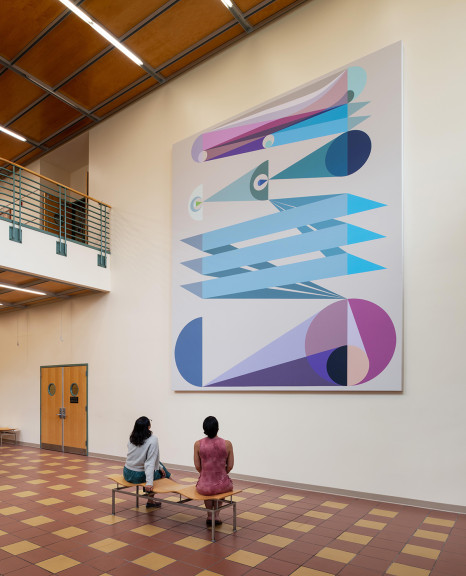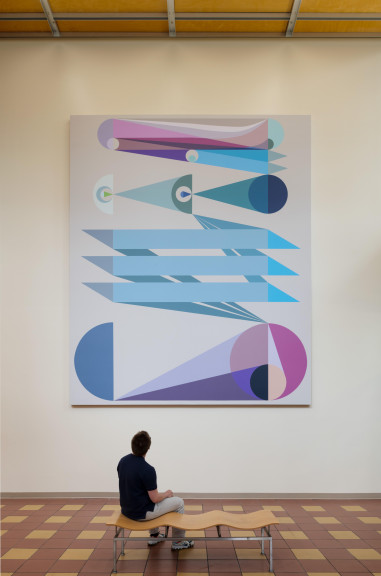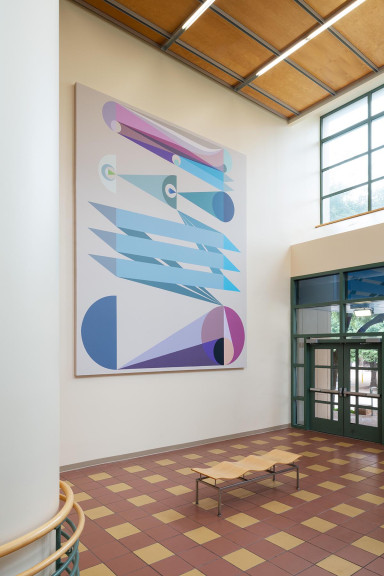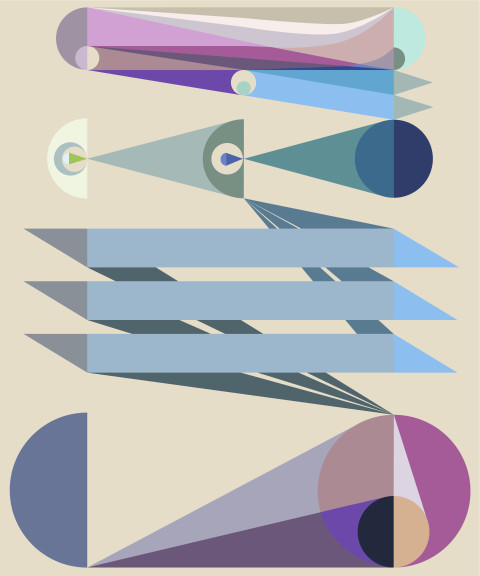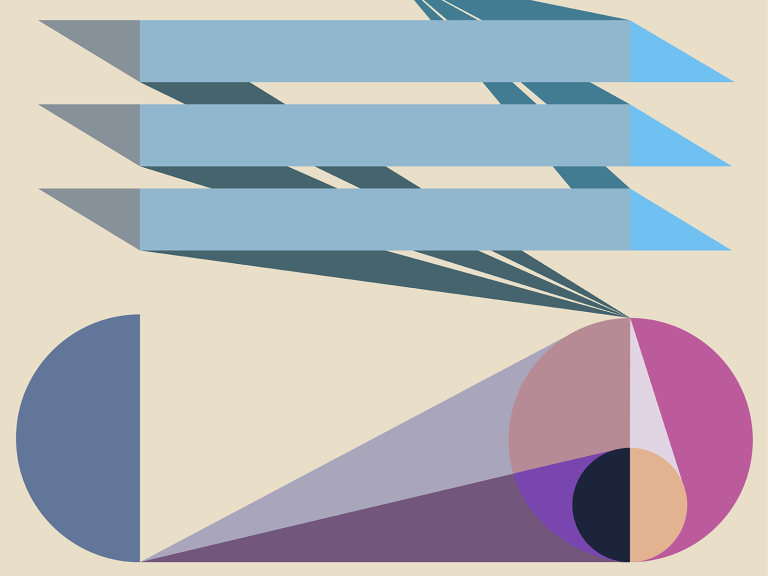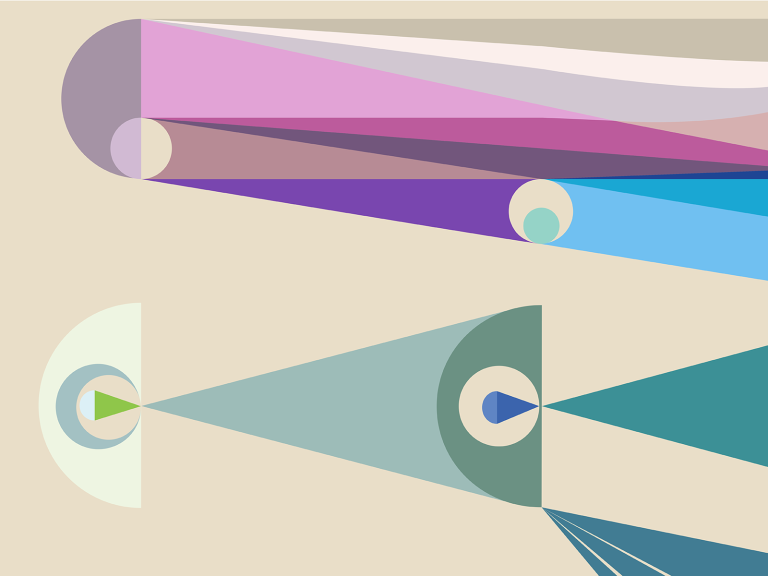Tras los ojos (Behind the Eyes)
Eamon Ore-Giron
187 × 156 inches
Commission, Landmarks, The University of Texas at Austin, 2023
GPS: 30.2897298, -97.7369794
Los Angeles–based artist Eamon Ore-Giron is interested in exploring the intersections of different cultures and identities. He is deeply connected to the Latinx community and challenges the erasure of its stories from art history and the broader North American public sphere. Drawing from a broad range of artistic movements and traditions, he produces a fresh visual language that creates new meanings as well as unexpected connections between European, pre-Columbian, contemporary Indigenous, and popular Latin American influences.
Ore-Giron created Tras los ojos (Behind the Eyes) for the university’s Department of Psychology. The art began as a small painting later reproduced as a large digital print on canvas. Its design was partly inspired by ophthalmological diagrams illustrating how visual information is processed. The artist’s personal history also influenced his decision to focus on the eye. At age twenty-eight, he noticed a small black spot in his vision. Initially dismissing it as temporary, he later discovered it was a genetic condition shared with his father. This condition played a pivotal role in his family’s decision to emigrate to the United States instead of settling in Peru. The experience encouraged Ore-Giron to reflect on the role of anatomy in our perception of reality.
While Tras los ojos (Behind the Eyes) employs the vocabulary of hard-edged geometric abstraction, it also references the natural world. The work’s palette of rich, solid colors evokes the moments before sunset, with a series of conical shapes and gradient rays in shades of purple, sky blue, and pale pink. Ore-Giron describes the gently curving lines at the top of the work as “the stratosphere of the painting,” and “the edge of the atmosphere where things start to bend.” The result is a striking metaphor for the flow of information between the external world and the mind.
ACTIVITY GUIDES
Tras los ojos (Behind the Eyes)
Eamon Ore-Giron
Subject: Construction
Activity: Overlapping shapes
Materials: Construction paper, scissors, glue, and paint (optional)
Vocabulary: Color, culture, familiar, geometric, mix, overlap, shape
Eamon Ore-Giron is inspired by many different cultures. His father was born in Peru and his mother’s family came from Ireland. He has lived in Caifornia, Arizona, Mexico, and Peru. When making his paintings, he thinks about how people from different places interact.
Tras los ojos (Behind the Eyes) is inspired by what and how our eyes see. The painting has lots of colors and shapes that look like the sky just before the sun goes down. The artist uses circles and zig zags in this painting to show what eyes look like inside of our heads.
What shapes do you see in this work of art?
What do the colors remind you of? How do they make you feel?
Does any part of this painting look like an eye to you?
- Cut out squares, triangles, and circles from different sheets of colored construction paper. Now overlap the pieces and move them around. Once you have the shapes laid out in a way that you like, glue them down to a separate piece of construction paper.
- With adult supervision: Use different colors of paint to make different shapes. Try overlapping the shapes in different ways.
This work of art was made by scanning the artist’s original painting on a computer and printing a copy of it. The original painting is much smaller, about the size of a laptop computer.
Look at your art. What do you see? Do the shapes you created and combined look like anything to you? Do they look similar to anything in Tras los ojos?
Color – The different shades and tones we see in the world around us.
Culture – A group of people that has shared beliefs, customs, and ways of living. Familiar – Something you have seen before.
Geometric – Simple shapes, such as lines, circles, squares, and triangles.
Mix – To combine different things together.
Overlap – When parts of something cover or lay on top of each other.
Shape – A form like a circle, square, or triangle.
Tras los ojos (Behind the Eyes)
Eamon Ore-Giron
Subject: Cultural heritage
Activity: Cultural influences in art
Materials: Paper and pencil
Vocabulary: Culture, heritage, Latinx, motif, perception, psychology, tradition
This art was inspired by diagrams that show how our eyes and vision work, as well as the artist's own experiences with a genetic condition that affects his sight. By drawing from various artistic influences, he encourages us to think about the role of culture and identity in art while examining how our eyes and minds work together to understand what we see.
Tras los ojos (Behind the Eyes), is filled with colors and shapes resembling a sunset sky, with rich hues of purple, sky blue, and pale pink. The shapes create a sense of movement and depth, inviting us to explore the work of art further. In this painting, the artist brings together elements from European, pre-Columbian, contemporary indigenous, and popular Latin American art, forming a fusion of styles that allows us to see unexpected connections between different artistic influences.
Can you think of any objects, food, or traditions that are important to your culture?
What do you use in your everyday life that is significant to your culture?
Look at this work simply as a piece of art. Does knowing about the cultures that influenced it cause you to see it differently?
- Partner up! Each person should write things down that make up their culture. This can include food, holidays, and beliefs that are important to your family.
- Then, take some time to draw a picture to represent some of these ideas and traditions.
- After both people are done, share your art with each other.
- You can do this activity alone by creating a list of things about culture, and then making a drawing depicting your culture.
This work of art was made by scanning and printing a copy of a painting. The painting is much smaller, about the size of a laptop computer.
Compare your partner’s art to your own. How are they similar? How are they different?
Culture – A group of people that has shared beliefs, customs, and ways of living.
Heritage – The special background or history of a person or group of people.
Latinx – People who come from Latin America or identify with Latin American origins.
Motif – A pattern or design that appears again and again in a piece of art.
Perception – The way we become aware of things through our senses.
Psychology – The study of how our minds work and how we think, feel, and act.
Tradition – The customs, beliefs, or ways of doing things that have been passed down through generations.
Tras los ojos (Behind the Eyes)
Eamon Ore-Giron
Subject: Perception
Activity: Changing the color of a work of art
Materials: Gel light filter plastic sheets and art supplies (such as paper, colored pencils, paint, modeling clay, etc.)
Vocabulary: Heritage, hybridity, Latinx, medium, perception
Los Angeles-based artist Eamon Ore-Giron is interested in exploring the intersections of different cultures and identities. His work reflects his deep connections to the Latinx community and is a challenge to the erasure of its stories from art history and the North American public sphere.
Tras los ojos (Behind the Eyes) uses a palette of rich, solid colors that evoke the moments before sunset. It features a series of conical shapes and gradient rays in shades of purple, sky blue, and pale pink. Ore-Giron describes the gently curving lines at the top of the work as “the stratosphere of the painting,” and “the edge of the atmosphere where things start to bend.” The result is a striking metaphor for the flow of information between the external world and the mind.
What is your favorite color? How does it make you feel?
Have you ever seen art with colors that stood out to you?
- Eamon Ore-Giron likes to practice in multiple mediums. Pick a medium of your choice and create something. It can be anything you want, such as a painting, drawing, or something out of clay!
- Then, use gel light filter plastic sheets and place it over your work of art.
This work of art was made by scanning and printing a copy of a painting. The painting is much smaller, about the size of a laptop computer.
How does the shift in color alter your perception of your art?
Heritage – The special background or history of a person or group of people.
Hybridity – The mixing of different things to create something new.
Latinx – People who come from Latin America or have family from there.
Medium – The material used by an artist such as paint or clay.
Perception – The way we become aware of things through our senses.
MORE INFORMATION
The unconscious dimensions of the mind have been an area of study since psychology was professionalized at the end of the nineteenth century. Despite the differences in various schools of thought, today each agrees that a large portion of perception occurs automatically, without interfering with conscious tasks. In this way, the unconscious information we receive is consequential, both in examining our internal states of mind and in our responses to the environment.
Spurred by a scientific mindset, Gestalt psychologists in the early 1900s became interested in studying perception. They attempted to identify general rules that would explain how the sensory fields are organized, particularly the visual. Early abstract artists associated with the school of Bauhaus saw a connection between this research and their quest to establish general artistic principles that would allow them to claim abstraction as a language that is universally applicable and independent of cultural and historical variables. At the end of the 1920s, and in one of the most significant instances of interaction between psychology and art, Gestalt psychologists were invited to Bauhaus to lead specialized seminars that brought together artists such as Josef Albers and Wassily Kandinsky. According to the Dutch art and science researcher Cretien van Campen, the striking similarities between early abstract painting and experimental Gestalt illustrations are the result of this reciprocal influence.
In Tras los ojos (Behind the Eyes)—a large-scale digital print adapted from a painting and commissioned by Landmarks for the university’s Department of Psychology—Eamon Ore-Giron illuminates and adds complexity to this story. On multiple occasions, the artist has referred to abstraction as the “root of perception,” and reaffirmed his interest in inscribing his public art projects within an abstract tradition that resists fixed meanings. Ore-Giron—who has been selected for significant public commissions in New York and Los Angeles—is aware of the importance of allowing his work to be quickly and viscerally read, especially when it is located in high-traffic spaces. However, his commitment to abstraction does not come at the expense of deeper discussion. On the contrary, as curator Ondine Chavoya has noted, Ore-Giron combines geometric and elemental forms to tell a story of intense cultural exchanges—a story that subverts the linearity of Eurocentric artistic genealogy and favors perspectives inspired by Latin American artistic traditions.
Permeating Ore-Giron’s work to varying degrees is a desire to investigate how cultures and identities entangle with each other, as they do in his own life, or to put it in another way, to explore the experiences and perspectives of those who embody mestizaje (“being mixed race”). The artist was born and raised in Tucson to a Peruvian father and a mother of Irish descent. Later, he pursued his BFA at the San Francisco Art Institute and his MFA at the University of California. Before moving permanently to Los Angeles, the artist spent time studying in Mexico City, and in Huancayo and Lima, Peru. Much later, he also lived in Guadalajara, Mexico, for a year.
In each of these contexts, Ore-Giron has been concerned with building bridges between diverse, and sometimes seemingly disparate, cultures, classes, and ideas and generating projects that include music, video, and that are distinguished by forging temporary communities based on dialogue and artistic experimentation. His paintings also reflect his deep affinity for the Latinx community and challenge the erasure of its stories from the North American public sphere. Curator Miranda Lash affirms that, in his figurative work of the early 2000s, Ore-Giron recreated a surreal world in which his family memories of the Peruvian Andes and the American Southwest fuse organically. At the same time, his recent geometric paintings explore the visual possibilities of intercultural influence, highlighting the persistence of marginalized forms as they become more integrated into the hegemonic culture.
In Ore-Giron’s work for Landmarks, a fascination with the intersection of psychology, art, and perception is evident. After talking with psychology faculty members, the artist chose the eye and the process of vision as a metaphor for the information that reaches the mind involuntarily. His biography also played a role in this decision. When Ore-Giron turned twenty-eight, he discovered a small black spot obstructing his vision. He initially believed it was temporary, but medical tests revealed it to be a genetic condition—linked to retinal detachment—that also afflicted his father and that ultimately led his family to emigrate to the United States instead of settling in Peru as his parents had planned. This episode encouraged Ore-Giron to reflect on the role of anatomy in our perceptions of reality. Tras los ojos combines scientific diagrams of how the human eye works while also drawing on the artist’s own experiences and impressions of moving between different cultures in the United States and Peru.
For Tras los ojos, Ore-Giron also found inspiration in Furturism’s sense of movement as well as the methods of Constructivism, which emphasize the process of production and the use of cutting-edge technology. Although the work appears to be a large-scale painting, it is a digital print on canvas, specially conceived for continuous display in a public space. However, in contrast with Constructivism’s preference for mechanical-industrial imagery, the artist integrated direct references to the natural world. For instance, observing the image, one is struck by the central zigzag that resembles lightening or a ray. And in a subtle but significant variation from other recent abstract pieces, Ore-Giron introduced softly curved lines and forms near the composition’s upper edge, a space he referred to as “the stratosphere of painting,” and “the edge of the atmosphere where things start to bend.”
Toward the center, the image gains momentum and appears to lift with energy. The palette of deep, solid colors evokes the moments of darkness before sunset, as various shades of purple, sky blue, and pale pink project conical shapes and gradient rays that appear to evaporate toward the borders. Ore-Giron designed the mural vertically, from bottom to top, applying the composition’s elements along two equidistant vertical lines. This totemic structure is reminiscent of some patterns of the neo-Concrete school of Latin America and Peruvian pre-Columbian textiles and architecture. Through the simultaneous citation of these various elements, the artist questions modernist and purist theories of form—including Gestalt—and shows that form is inherently social and political. In doing so, his work expands the artists, communities, and geographies traditionally related to abstraction.
Ore-Giron’s artistic practice creates a shared space where European, pre-Columbian, contemporary indigenous, and popular Latin American influences coexist. This polyvocal vision not only challenges the foundational myths of artistic modernity but also opens a necessary dialogue about the representation and participation of the Latino community in the United States. Despite extreme economic, ethnic, racial, and national diversity, Latinos have been the largest minority in North America since around 2001. By prioritizing family migration and diaspora stories over national-patriarchal narratives, the artist highlights the diversity of a community that lives within multiple cultural traditions. In today’s increasingly xenophobic environment, the intercultural and interdependent future imagined by Ore-Giron’s work is more relevant than ever.
Florencia Portocarrero
January 2023
Eamon Ore-Giron Bibliographic Highlights
Falconi, Jose. "No Me Token: o cómo asegurarnos de nunca perder el * por completo," the Guggenheim UBS MAP Global Art Initiative. (2014). https://www.guggenheim.org/blogs/map/token-o-como-asegurarnos-de-nunca-perder-el-por-completo
Freundlich, Otto. Cosmic Communism. Cologne: Museum Ludwig, 2017.
Lash, Miranda, C. Ondine Chavoya, and Jace Clayton. Eamon Ore-Giron: Competing with Lightning. New York: Rizzoli International Publications, 2022.
Ore-Giron, Eamon. Infinite Regress. Berlin: Bom Dia Boa Tarde Boa Noite, 2020.
Paternosto, César. The Stone and the Thread: Andean Roots of Abstract Art. Austin: University of Texas Press, 1996.
Eamon Ore-Giron project history
Landmarks commissioned artist Eamon Ore-Giron to create a work of art for the Seay building (SEA), which houses the Department of Psychology. Funding for Tras los ojos (Behind the Eyes) was provided by the SEA capital improvement project for the College of Liberal Arts. Landmarks gives special thanks to the following:
Leadership
Andrée Bober and Landmarks
Jay Hartzell and the Office of the President
Landmarks Advisory Committee
Ramón Rivera-Servera and the College of Fine Arts
Ann Stevens and the College of Liberal Arts
The Office of Business Strategies and Operations
The Office of Financial and Administrative Services
Sharon Wood and the Office of the Executive Vice President and Provost
Project Team
Nisa Barger, project manager, Landmarks
Andrée Bober, curator and director, Landmarks
Duggal Visual Solutions, printing and fabrication
Bill James, project manager, Campus Construction
QA Construction Services, Inc., construction
Eamon Ore-Giron, artist
Robert Gonzales, art installation
Special Thanks
Paul Bardagjy, photography
Grant Barger, facilities director, Liberal Arts ITS
Richard Carpenter and RC Creative, videography
Frank Bross, collections, Landmarks
Ondine Chavoya, Department of Art and Art History
Alexandra Clark, assistant professor, Department of Psychology
Anoush Crane, event planner, Landmarks
Jane Cohan, James Cohan Gallery
Madeline Divine, graduate student, Department of Psychology
Audrey Duarte, professor, Departments of Psychology and Neurology
Jacqueline Evans, associate professor, Department of Psychology
André Fuqua, development, Landmarks
Bill Haddad, technology manager, Landmarks
Arianna Hernandez-Baptiste, education, Landmarks
Hirokazu Horikoshi, QA Construction Services, Inc.
Logan Larsen, communications, Landmarks
M.E. Laursen, The Contemporary Austin
Dorothy Lin, design, Landmarks
sharon maidenberg, The Contemporary Austin
Julie Le, The Contemporary Austin
Alex Klein, The Contemporary Austin
Tyler Megehe, Campus Construction
Marie Monfils, professor, Department of Psychology
Liz Myrick, department manager, Department of Psychology
Rachel Nawi, studio manager, Eamon Ore-Giron studio
David Norr, James Cohan Gallery
Meaghan Perry, conservator, Momentum Conservation
Franco Pestilli, associate professor, Department of Psychology
Florencia Portocarrero, curatorial contributor
Brian Roberts, associate dean and director, College of Liberal Arts
Emily Ruotolo, James Cohan Gallery
David Schnyer, chair, Department of Psychology
Marina Stark, project manager, Dugal Visual Solutions
MacKenzie Stevens, director, Visual Arts Center
Kathleen Brady Stimpert, deputy director, Landmarks
Stephanie Taparauskas, development, Landmarks
Joe TenBarge, former assistant dean, Liberal Arts ITS
Thao Votang, operations, Landmarks
Catherine Whited, education, Landmarks
Chen Yu, professor, Department of Psychology

